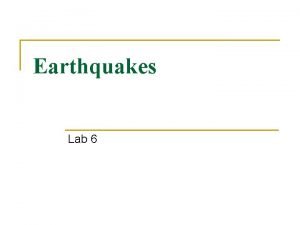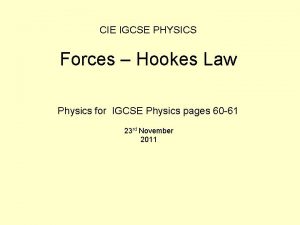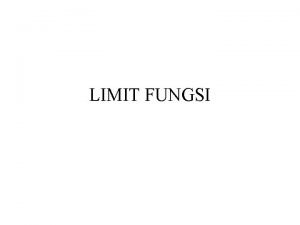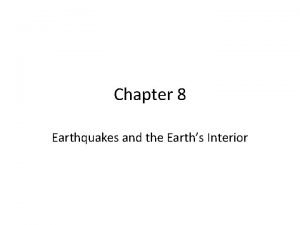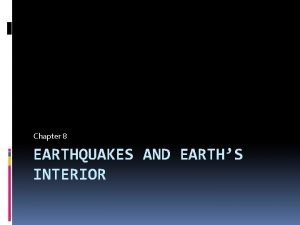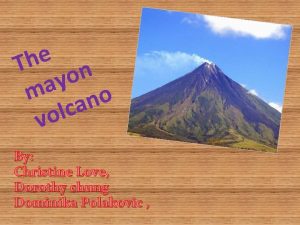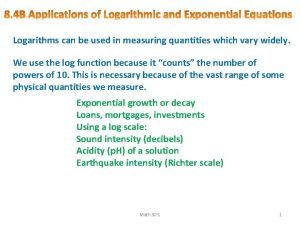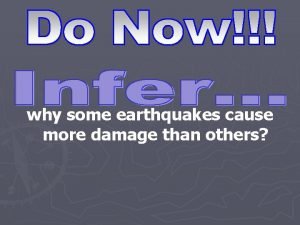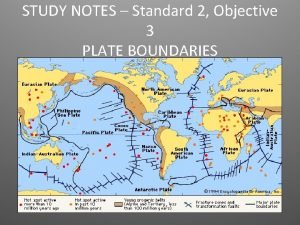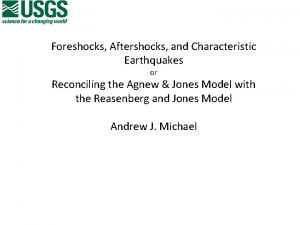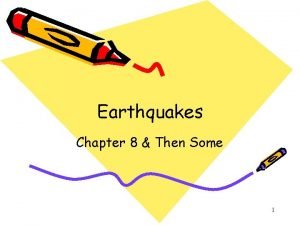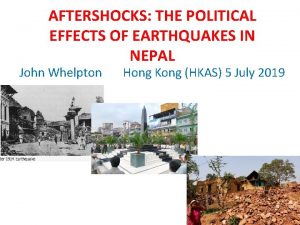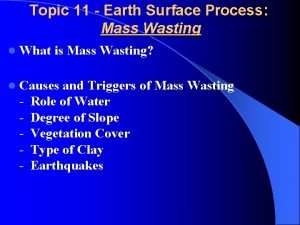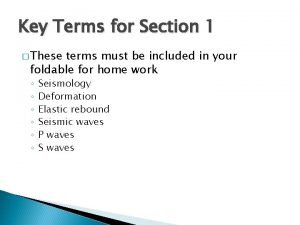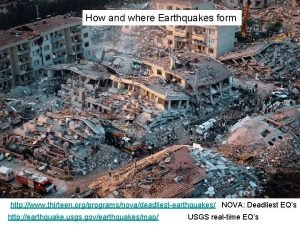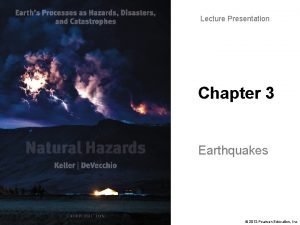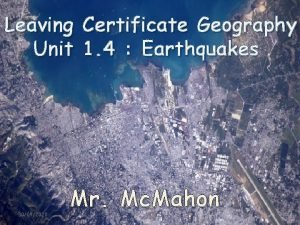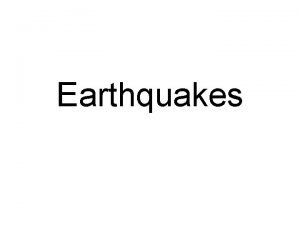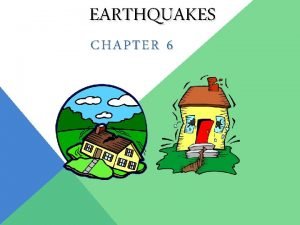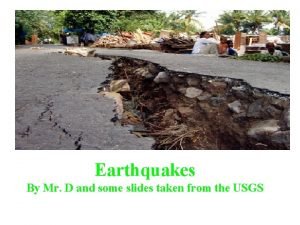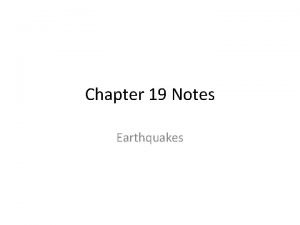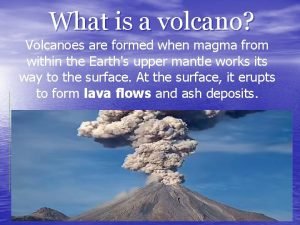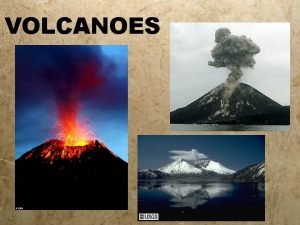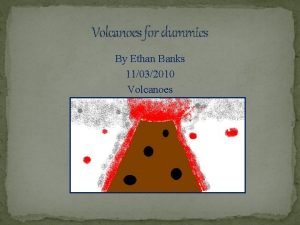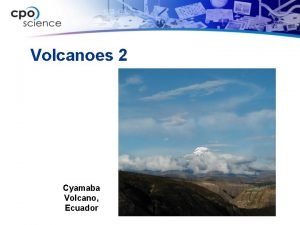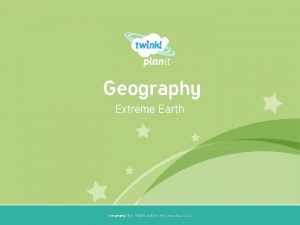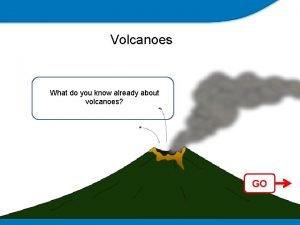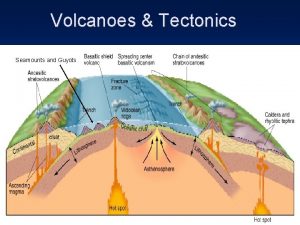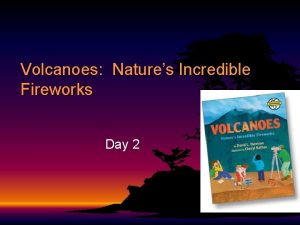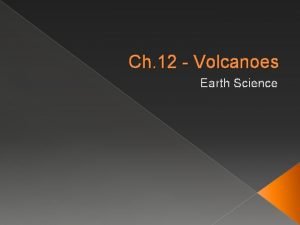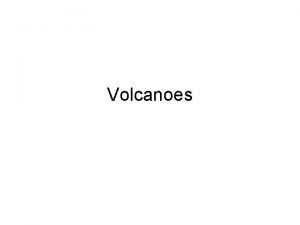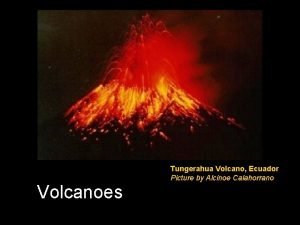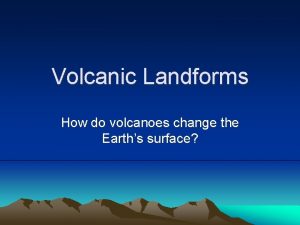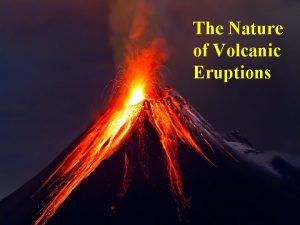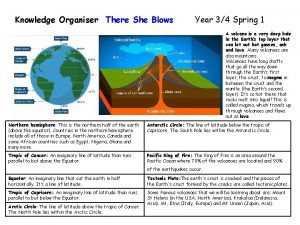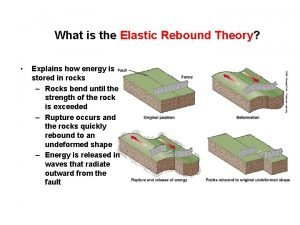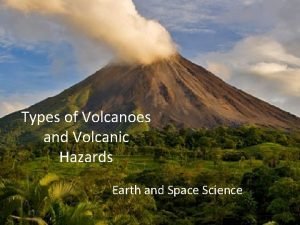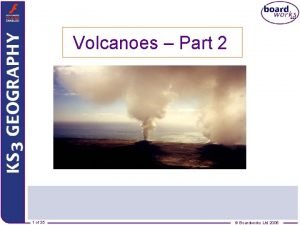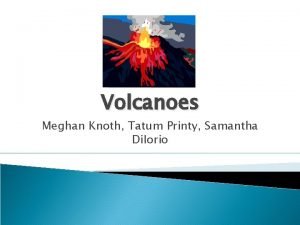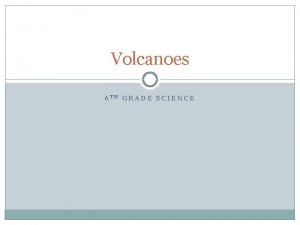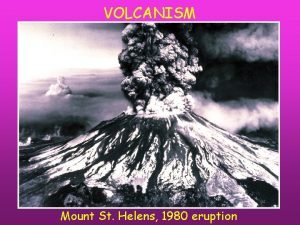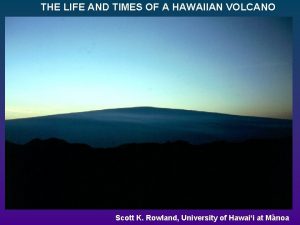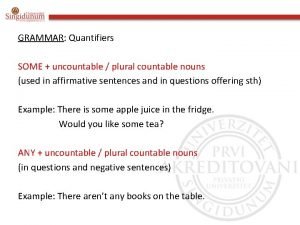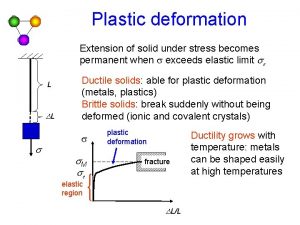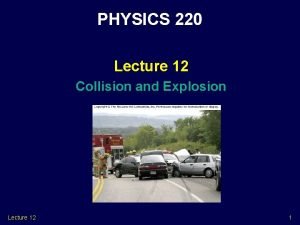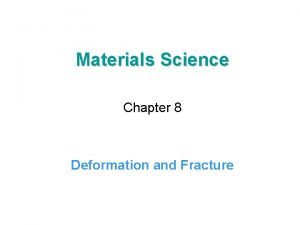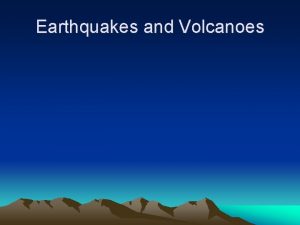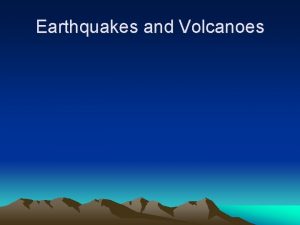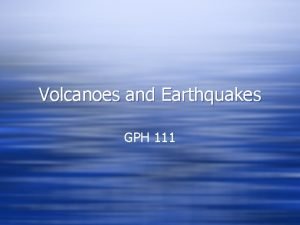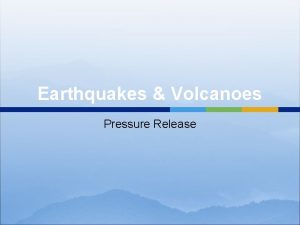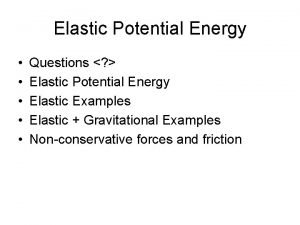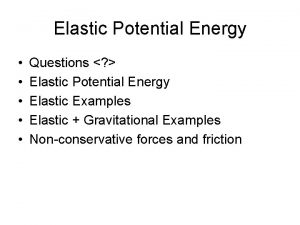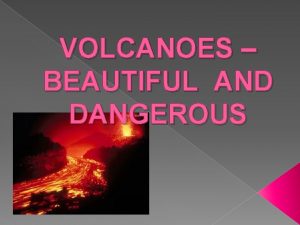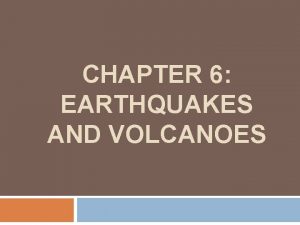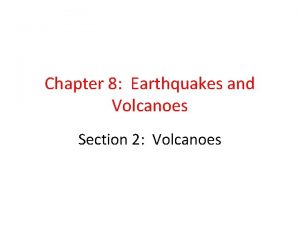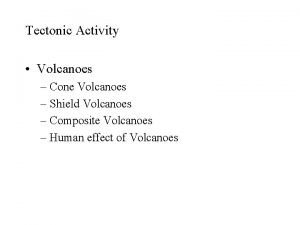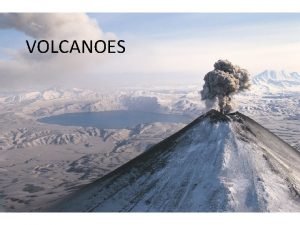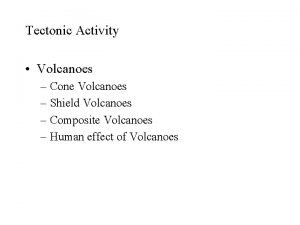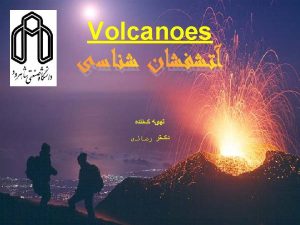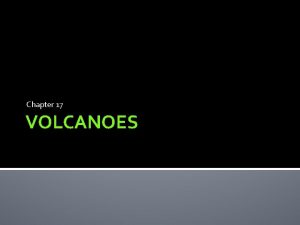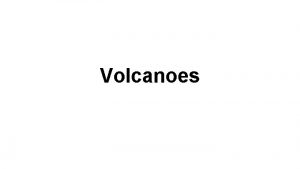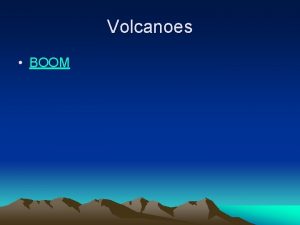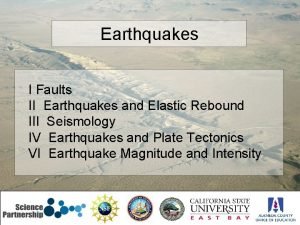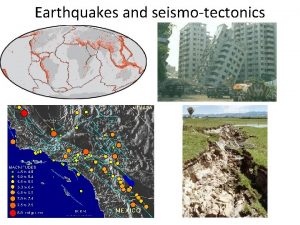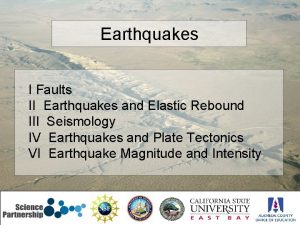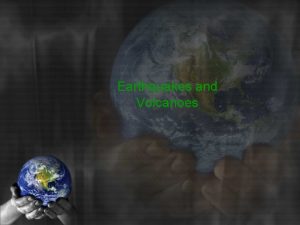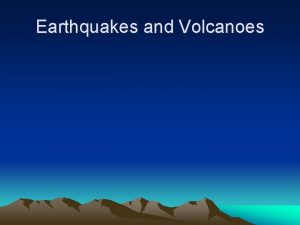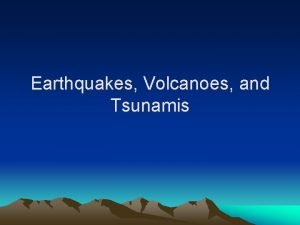Earthquakes and Volcanoes Elastic Limit There is an

































































- Slides: 65

Earthquakes and Volcanoes

Elastic Limit • There is an elastic limit to the amount a rock can bend and stretch before it will break. • Once the limit is passed, the rock will move along a fault line.

Earthquakes • An earthquake is the shaking and trembling that results from the sudden movement of the rock along the fault. • Energy is released. The earthquake will continue until the energy is used up.

Fault Line

Three Types of Force • Compression is the force that squeezes rock together. • Tension is the force that pulls rocks apart. • Shearing is the force that causes rocks on either side of a fault to slide past each other.

Faults • Tension causes rocks to be pulled apart and the rocks move down along the fault line. • Compression causes rocks to squeeze together and rocks move up along a fault line. • Strike slip is side by side.

Himalayan Mountains • The Himalayan Mountains which were formed by the convergence (compression) of Indo -Australian Plate and the Eurasian Plate has many reverse and thrust faults.

Seismic Waves • The waves of energy generated by an earthquake are called seismic waves. • There are three main types of seismic waves. • Primary (P waves) • Secondary (S waves) • Surface (L waves)

San Andreas Fault • The San Andreas fault extends 960 km from Mexico to the north of California. • The land to the west is moving north. The land to the east of the fault is moving south. All the rocks do not move at the same time so earthquakes occur in one area and then another.

Focus • Most faults occur between the surface and a depth of 70 kilometers. • The point beneath the surface where the rocks break and move is called the focus. The focus is the underground origin of an earthquake.

Epicenter • Directly above the focus, on the Earth’s surface is the epicenter. Earthquake waves reach the epicenter first. During an earthquake, the most violent shaking is found at the epicenter.

Primary Waves • Seismic waves that travel fastest are P waves. They travel through solids, liquids and gases. • They move at different speeds depending on the density of the material through which they are moving. As they move deeper in the Earth they move faster. • P waves are push-pull waves.

Secondary Waves • Seismic waves that do not travel through the Earth as fast as P waves do are called secondary or S waves. • S waves travel through solids but not liquids or gases. • S waves cause particles to move from side to side. They move at right angles to the direction of the wave.

P and S Waves

Surface Waves • The slowest moving seismic waves are called surface waves or L waves. • L waves originate on the Earth’s surface at the epicenter. They move along the surface the way waves travel in the ocean. The Earth’s surface moves up and down and side to side with each L wave. • L waves cause most of the damage.

The Seismograph • Invented in 1893 by John Milne, a seismograph detects and measures seismic waves. • A weight attached to a spring remains nearly still even when the Earth moves. A pen attached to the weight records any movement on a roll of paper on a constantly rotating drum. The drum moves with the Earth and affects the line.

Seismograph

Seismologists • Seismologists study earthquakes. They can determine the strength of an earthquake by the height of the wavy line recorded on the paper. • The seismograph record of waves is called a seismogram.

Scales Used to Measure Earthquakes • The Richter scale is used to calculate the strength (magnitude) of an earthquake. • The Modified Mercalli is used to measure the intensity (amount of destruction) of an earthquake.

Seismograph Stations • Each type of wave reaches a seismograph station at a different time based on its speed. • Primary waves arrive first. Secondary waves travel slower and arrive later. • The difference in arrival time is used to estimate the distance from the station to the epicenter.

Locating an Epicenter • Scientists need readings from three or more stations to determine the location. A circle is drawn around each station. The radius of each circle is equal to the station’s distance from the epicenter. • The point of intersection is the location of the epicenter.

Interior of the Earth • Seismic waves change speed as they move through the earth’s layers. They speed up when they pass through the bottom of the crust and enter the mantle. This boundary is known as the Moho.

The Moho • The boundary is named for the scientist, Andrija Mohorovicic who discovered this information. • It is called the Mohorovicic discontinuity or Moho.

Seismic Speed in the Mantle • The mantle is divided into layers based on changes in seismic wave speed. Both P and S waves slow down again when they reach the asthenosphere. • They speed up when they move through a more dense part of the mantle.

Predicting Earthquakes • Scientists need to know the amount of stress applied as well as the elastic limit of the rock to determine when an earthquake will occur.

Predicting Earthquakes • Scientists have identified warning signals the help predict earthquakes with greater accuracy. • Often changes occur in the speed of P and S waves before an earthquake occurs. • Sometimes slight changes in the tilt of the Earth’s surface can be detected. • Some scientists believe animals behavior is affected.

Seismic Speed in the Core • The core is divided into two layers based on how they travel through it. • Primary waves slow down and secondary waves do not travel through the liquid outer core. • Primary waves speed up again when they reach the solid inner core.

Seismic Risk Map of the U. S.

The Richter Scale measures the strength or magnitude • An increase of one magnitude on the Richter scale means that 32 times more energy is released. • An earthquake of magnitude 6 is 32 x 32 times greater than an earthquake with a magnitude of 3.

Magnitude • The height of the lines traced on the paper of a seismograph is a measure of the energy that is released, or the magnitude of an earthquake.

The Modified Mercalli Scale measures the amount of damage • Earthquakes can also be described by the amount of damage they cause. The Modified Mercalli scale describes the intensity of an earthquake using the amount of structural and geologic damage in a location.

Earthquake Damage • The amount of damage created by an earthquake depends on several factors. • The earthquake’s strength • The kind of rock and soil that underlies an area • The population of the area • The kind of buildings in the area • The time at which the earthquake occurs

Earthquake Belts Worldwide

Tsunamis • Earthquakes which occur on the ocean floor produce giant sea waves called tsunamis. Tsunamis can travel at speeds of 700 to 800 km per hour. As they approach the coast, they can reach heights of greater than 20 meters. • The Tsunami Warning Center is located in Hilo, Hawaii.

Volcanoes • A volcano is an opening in the Earth that erupts gases, ash and lava. • Kilauea is the world’s most active volcano.

Formation of a Volcano

Magma Deep within the Earth, under tremendous pressure and at great temperatures, rock exists as a hot liquid called magma. This molten rock is found in pockets called magma chambers.

Viscosity of Magma

Lava • When the magma reaches the surface, it is called lava. The place in the Earth’s surface through which magma and other materials reach the surface is called a volcano. In some places, lava can build up to form a cone-shaped mountain. • The opening from which lava erupts is the vent. Volcanoes often have more than one vent.

Dark-Colored Lava • There are four types of lava. • One is dark-colored and contains a lot of water. This is rich in iron and magnesium and cools to form igneous rocks such as basalt. This lava is thin and runny and most tends to flow. The islands of Hawaii and Iceland were formed by many lava flows.

Light-Colored Lava • The second type of lava is light in color. This lava, contains little water and is rich in silicon and aluminum. Light-colored lava causes explosive eruptions. Silicon tends to harden in the vents and form rocks. Steam and new lava build up under the rocks. When the pressure becomes great, a violent explosion occurs. When this type of lava cools it form the igneous rock, rhyolite, which resembles granite.

Combination Lava • The third type of lava has a chemical composition similar to that of both the dark -colored type and the light-colored type. Different varieties of igneous rocks in the Earth’s crust, such as andesite, are form from this type of lava.

Gaseous Lava • The fourth type of lava contains large amounts of gases such as steam and carbon dioxide. When this lava hardens, it forms rocks with many holes in them, due to gas bubbles. Pumice and scoria are igneous rocks formed from this type of lava.

Volcanic Eruptions • During volcanic eruptions, many rock fragments are blown into the air. The smallest particles are called volcanic dust. (less than 0. 25 mm) • Volcanic Ash ( 0. 25 -5 mm) falls to the Earth and forms small rocks. • Volcanic bombs (a few cm to several meters) are molten and harden as they travel through the air.

Types of Volcanoes • Different types of volcanic eruptions form different types of volcanoes. • Cinder cones • Shield volcanoes • Composite volcanoes

Cinder Cones • Volcanoes made mostly of cinders and other rock particles that have been blown into the air are called cinder cones. Cinder cones form from explosive eruptions. Because the material is loosely arranged, the cones are not high. The have a narrow base and steep sides such as Paricutin in Mexico.

Cinder Cone Volcano

Shield Volcanoes • Volcanoes composed of quiet flows are called shield volcanoes. Because it is rummy, the lava flows over a large area. After several eruptions, a dome-shaped mountain is formed such as Mauna Loa (4 km over sea level) in the Hawaiian Islands.

Shield Volcanoes

Composite Volcanoes • Volcanoes built up of alternating layers of rock particles and lava are called composite volcanoes. During the formation of a composite volcano, a violent eruption first occurs, hurling volcanic bombs, cinder and ash out of the vent. Then a quiet eruption, produces lava flow that covers the rock particles. After alternating eruptions, a cone-shaped mountain forms such as Mount Vesuvius.

Mount Vesuvius

Mount Vesuvius • Images of victims in eruption of Vesuvius in 79 AD. Most died as a result of suffocation.

Composite Volcano

Crater • There is often a funnel-shaped pit or depression at the top of a volcanic cone. This pit is called a crater. If the crater becomes very large as a result of the collapse of its walls, it is called a caldera. A caldera may also form when the top of a volcano explodes or collapses.

Volcanic Crater

Volcanic Activity • Volcanoes are rather unpredictable. Some erupt regularly, others have not erupted in modern history. Scientists classify them as active, dormant or extinct.

Active Volcanoes • An active volcano is one that erupts wither continually or periodically such as Mount Katmai in Alaska and Mount St. Helens in the Cascade Range.

Dormant Volcano • A volcano that has been known to erupt within modern times but is now inactive is classified as a dormant volcano. Mount Rainier in Washington state are example of dormant volcanoes in the United States.

Extinct Volcano • A volcano not known to have erupted within modern history is classified as an extinct volcano. They have been worn away almost to the level of their magma chamber. Scientists can be wrong. Mount St. Helens was considered to be dormant but erupted after long periods of inactivity.

Volcano and Earthquake Zones • Most major earthquakes and volcanic eruptions occur in three zones of the world. Scientists believe that there is a great deal of movement and activity in the Earth’s crust in these three zones.

Ring of Fire • One major earthquake and volcano zone extends nearly all the way around the edge of the Pacific Ocean. This zone goes through New Zealand, the Philippines, Japan, Alaska and along the western coasts of North and South America. The San Andreas fault is part of this zone.

Ring of Fire

Mediterranean Zone • A second Major earthquake and volcano zone is located near the Mediterranean Zone and extends across Asia into India. Many countries in the zone, including Italy, Greece and Turkey, have violent earthquakes. Many volcanic eruptions also occur in this zone.

Mid-Atlantic Ridge Zone • The third major earthquake and volcano zone extends through Iceland to the middle of the Atlantic Ocean. There is under the ocean a long range of volcanic mountains called the Mid-Atlantic Ocean Range. Scientists believe that the volcano and earthquake activity are due to the formation of new parts of the Earth’s crust along the ridge. The volcanic island of Iceland is part of this zone.

Earthquake Belts
 Chapter 8 earthquakes and volcanoes
Chapter 8 earthquakes and volcanoes Elastic cartilage elastic fibers
Elastic cartilage elastic fibers Distrophism
Distrophism Force extension graphs
Force extension graphs Igcse
Igcse Upper specification limit and lower specification limit
Upper specification limit and lower specification limit Natural variations operations management
Natural variations operations management Grafik limit
Grafik limit Chapter 8 section 2 earthquake measurement answer key
Chapter 8 section 2 earthquake measurement answer key Chapter 8 earthquakes and earth's interior
Chapter 8 earthquakes and earth's interior Chapter 8 earthquakes and earth's interior answer key
Chapter 8 earthquakes and earth's interior answer key Interesting facts about mt mayon
Interesting facts about mt mayon Constructive forces and destructive forces
Constructive forces and destructive forces In what section of earth do earthquakes happen
In what section of earth do earthquakes happen Btn earthquakes
Btn earthquakes Hazard picture
Hazard picture Http://earthquake.usgs.gov/earthquakes/map/
Http://earthquake.usgs.gov/earthquakes/map/ A large crack in the earth formed by a river or earthquakes
A large crack in the earth formed by a river or earthquakes Chapter 19 earthquakes
Chapter 19 earthquakes Why some earthquakes cause more damage than others
Why some earthquakes cause more damage than others Frequent earthquakes in an area may indicate
Frequent earthquakes in an area may indicate Earthquakes
Earthquakes Chapter 8 quiz 1
Chapter 8 quiz 1 Earthquakes
Earthquakes Mass wasting processes
Mass wasting processes Elastic rebound
Elastic rebound Why do earthquakes occur
Why do earthquakes occur Epicenter of earthquake
Epicenter of earthquake Pearson education
Pearson education Earthquake damage scale
Earthquake damage scale The point on the ground directly above the focus
The point on the ground directly above the focus Causes of earthquake
Causes of earthquake What are the factors of earthquake
What are the factors of earthquake Types of earthquake
Types of earthquake Chapter 19 earthquakes
Chapter 19 earthquakes Volcano formation
Volcano formation How are volcanoes classified
How are volcanoes classified Paboeboe
Paboeboe Where do most volcanoes occur
Where do most volcanoes occur How are volcanoes made
How are volcanoes made What do you already know about volcanoes?
What do you already know about volcanoes? Three main ways volcanoes are created
Three main ways volcanoes are created Volcanoes nature's incredible fireworks
Volcanoes nature's incredible fireworks Explain the theory of plate tectonics.
Explain the theory of plate tectonics. How are volcanoes formed
How are volcanoes formed Volcanic belts form along _____.
Volcanic belts form along _____. Active volcanoes map
Active volcanoes map Krakatoa volcano
Krakatoa volcano Paricutin materials extruded
Paricutin materials extruded Volcanoes knowledge organiser
Volcanoes knowledge organiser Elastic rebound theory explains
Elastic rebound theory explains Types of volcanoes
Types of volcanoes Ring of fire volcanoes
Ring of fire volcanoes Types of volcanoes according to shape
Types of volcanoes according to shape Shield volcanoes
Shield volcanoes Factors affecting volcanic eruption
Factors affecting volcanic eruption Name volcanoes
Name volcanoes Where are volcanoes
Where are volcanoes A'a hawaiian
A'a hawaiian Volcanoes of italy map
Volcanoes of italy map Pep unit
Pep unit There is there are countable uncountable nouns
There is there are countable uncountable nouns Sightseeing countable or uncountable
Sightseeing countable or uncountable Slip systems
Slip systems A freight train is being assembled in a switching yard
A freight train is being assembled in a switching yard Elastic and plastic deformation
Elastic and plastic deformation


